#helen traubel
Explore tagged Tumblr posts
Text

#movies#polls#the ladies man#the ladies man 1961#the ladies man movie#60s movies#jerry lewis#helen traubel#pat stanley#kathleen freeman#george raft#requested#have you seen this movie poll
44 notes
·
View notes
Text
Novembre MMXXIV "November Who"
Films
Daleks' Invasion Earth : 2150 A.D. (1966) de Gordon Flemyng avec Peter Cushing, Bernard Cribbins, Ray Brooks, Andrew Keir, Roberta Tovey, Jill Curzon et Roger Avon
Family Business (1989) de Sidney Lumet avec Sean Connery, Dustin Hoffman, Matthew Broderick, Rosanna Desoto, Janet Carroll et Victoria Jackson
Le Distrait (1970) de et avec Pierre Richard et Bernard Blier, Marie-Christine Barrault, Maria Pacôme, Catherine Samie, Micheline Luccioni, Paul Préboist, Tsilla Chelton et Robert Dalban
Elvis et Nixon (Elvis and Nixon) (2016) de Liza Johnson avec Michael Shannon, Kevin Spacey, Alex Pettyfer, Johnny Knoxville, Colin Hanks, Evan Peters et Sky Ferreira
Scandale à la cour (Olympia) (1960) de Michael Curtiz et Mario Russo avec Sophia Loren, Maurice Chevalier, John Gavin, Angela Lansbury, Isabel Jeans, Tullio Carminati et Milly Vitale
Monsieur Aznavour (2024) de Grand Corps Malade et Mehdi Idir avec Tahar Rahim, Camille Moutawakil, Gulia Avetisyan, Bastien Bouillon, Marie-Julie Baup, Lionel Cecilio et Hovnatan Avédikian
Les Sentiers de la gloire (Paths of Glory) (1957) de Stanley Kubrick avec Kirk Douglas, George Macready, Ralph Meeker, Timothy Carey, Joe Turkel, Adolphe Menjou et Wayne Morris
L'Alibi (1937) de Pierre Chenal avec Louis Jouvet, Jany Holt, Erich von Stroheim, Albert Préjean, Margo Lion, Fun-Sen, Véra Flory et Génia Vaury
L’Exercice de l’État (2011) de Pierre Schoeller avec Olivier Gourmet, Michel Blanc, Zabou Breitman, Laurent Stocker, Sylvain Deblé, Didier Bezace, Jacques Boudet, François Chattot et Anne Azoulay
Drôle de missionnaire (The Missionary) (1982) de Richard Loncraine avec Michael Palin, Maggie Smith, Phoebe Nicholls, Trevor Howard, Graham Crowden, Denholm Elliott, Michael Hordern et Rosamund Greenwood
Les Félins (1964) de René Clément avec Alain Delon, Jane Fonda, Lola Albright, Sorrell Booke, Carl Studer, André Oumansky, Arthur Howard et George Gaynes
Docteur ? (2019) de Tristan Séguéla avec Michel Blanc, Hakim Jemili, Solène Rigot, Artus, Franck Gastambide, Fadily Camara et Lucia Sanchez
La Séductrice (A Good Woman) (2004) de Mike Barker avec Scarlett Johansson, Helen Hunt, Tom Wilkinson, Mark Umbers, Stephen Campbell Moore, Milena Vukotic et Roger Hammond
Graine de violence (Blackboard Jungle) (1955) de Richard Brooks avec Glenn Ford, Anne Francis, Margaret Hayes, Vic Morrow, Sidney Poitier, Warner Anderson, Louis Calhern, Rafael Campos et Jamie Farr
Peter Gunn, détective spécial (Gunn) (1967) de Blake Edwards avec Craig Stevens, Laura Devon, Edward Asner, Albert Paulsen, Sherry Jackson, Marion Marshall et Helen Traubel
Doctor Who : Le Fandom Français (2019) de Julien Cadart Serizel, Pauline Cadart Serizel et Thomas Pouchin avec Alexandre Blondel, Carine Boxho, Nino Bréant, Mathéo De Lima, Marie Devigne, Romana Doc, Julien Evrard et Antony Fromaget
Séries
Doctor Who Season 20, 1 Series 1, 4, 6, 9, 12, 14
Mawdryn Undead - Father's Day - Terminus - The Doctor's Daughter - The Daleks - Enlightenment - The Curse of the Black Spot - Sleep No More - Praxeus - Rogue - The King's Demons - The Five Doctors
Psych Saison 3, 4, 5
Noël au balcon, tout le monde en prison - Six pieds sous la mer - Sale temps pour Lassiter - Au feu le médium - L'Enfer du vendredi - Plus menteur, tu meurs - Mardi 17, le retour de Jason - Une soirée avec Mr Yang - Mission Canada - Famille, je vous aime - Petits arrangements avec le Diable - Presque cent dollars pour un Shérif - La Peur des balles - Meurtre à Bollywood - À qui le tour ? - La Nuit du Loup-Garou - Y a-t-il quelqu'un pour sauver Shawn ? - En avant soldat ! - Sensations trop fortes - Rendez-vous dans sept ans - Le Groupe de Réflexion - À vos masques… - Dans le ventre de la bête - Mr Yin présente… - La Guerre débridée - La Botte secrète - Soucoupes flippantes - La classe qui tue - À toute vitesse - Un duo vintage - Mer agitée - Alter ego - Partir un jour… - En cabane au Canada
Friends Saison 3, 4, 5
Celui qui avait un tee-shirt trop petit - Celui qui courait deux lièvres - Celui qui avait un poussin - Celui qui s'énervait - Celui qui avait un truc dans le dos - Celui qui voulait être ultime champion - Celui qui allait à la plage - Celui qui soignait les piqûres de méduses - Celui qui ne voyait qu'un chat - Celui qui avait des menottes - Celui qui apprenait à danser - Celui qui avait une nouvelle copine - Celui qui fréquentait une souillon - Celui qui poussait le bouchon - Celui qui était dans la caisse - Celui qui savait faire la fête - Celui qui draguait au large - Celui qui posait une question embarrassante - Celui qui gagnait les paris - Celui qui se gourait du tout au tout - Celui qui n'avait pas le moral - Celui qui jouait au rugby - Celui qui participait à une fête bidon - Celui qui avait la chaîne porno - Celui qui cherche un prénom - Celui qui faisait de grands projets - Celui qui va se marier - Celui qui envoie l'invitation - Celui qui était le pire témoin du monde - Celui qui se marie : première partie - Celui qui se marie : deuxième partie - Celui qui avait dit Rachel - Celui qui embrassait - Celui qui a des triplés - Celui qui accepte l'inacceptable - Celui qui rate son week-end - Celui qui a du mal à se taire - Celui qui emménage - Celui qui avait des souvenirs difficiles à avaler - Celui qui s'était fait piquer son sandwich - Celui qui avait une sœur un peu spéciale
Astrid, Raphaëlle et Alexandre Ehle
Œil pour Œil
Dans l'ombre
50,47 % - Le chat noir - La riposte - Élu par la foudre - Danse sur un volcan - L'odeur de l'essence
Opération Trafics
Procédure exceptionnelle - Drôle de pastis - La Bataille de l'or - La Sainte Famille - W… comme Watteau - T.I.R
Astrid et Raphaëlle Saison 1
Puzzle - Hantise 1 - Hantise 2 - Chaînon manquant - Chambre close - Fulcanelli - L'Homme qui n'existait pas - La Mort et Compagnie - Invisible
Les enquêtes Caméléon
Trou de mémoire - Un panier de crabes - Les Gens d'en face
Cat's Eyes Saison 1
Tamara - Sylia - Alexia - Quentin - Gwen - Prudence
Les Enquêtes de Vera Saison 13
Délit de fuite
Spectacles
Portishead : Roseland NYC Live (1998)
Tant qu'il y a de l'amour (2019) de Bob Martet avec Marie-Anne Chazel, Patrick Chesnais, Valérie Bègue et Laurent Gamelon
Play the Blues: Live from Jazz at Lincoln Center, Wynton Marsalis and Eric Clapton (2011)
Charles Aznavour : Au Carnegie Hall (1995)
Charles Aznavour : Symphonique au Théâtre du Chatelet (1981)
Mascarin (1973) de et avec Michel de Ré et Micheline Dax, Alain Lionel, Arlette Didier, Francis Lax, Jean Péméja et Virginie Vignon
U2: Rattle and Hum (1988)
Amy Winehouse: Live at Porchester Hall (2007)
Doctor Who at the Proms (2013) avec Neve McIntosh, Dan Starkey, Matt Smith, Jenna Coleman, Carole Ann Ford, Peter Davison, Nicholas Briggs, Ben Foster et Murray Gold
Grand Concert de la fête de la Sainte Cécile (2024) par l'orchestre d'harmonie d'Albi et l'orchestre cadet de la fédération du Tarn
Santana: Supernatural Live (2000)
Nina (1979) de Jean Laurent Cochet avec Jacques Sereys, Louis Velle, Rosy Varte, Yves Marchand et Gérard Pollet
Livres
Doctor Who : Il était une fois un Seigneur du Temps de Dan Slott, Christopher Jones, Matthew Dow Smith, Mike Collins et David Guelou
Les contes de l'infini de Flavia Valerio, Pauline Cadart Serizel, Rémi Germain, Marion Lemaître, Manon Segur, Robin Brou, Julien Cadart Serizel et Marie Valerio
Doctor Who : Le douzième docteur, tome 2 : Fractures de Robbie Morrison, Brian Williamson et Mariano Laclaustra
Doctor Who : L'Armée oubliée de Brian Minchin
Les Daleks envahissent la terre de Terrance Dicks
0 notes
Text


Daily dose of Jer
Jerry in first photo: "hey...hey...I'm about to be cute...like, really super cute...and adorable...are you ready??"
Jerry in second photo: teeeeheeee am too cute even for me
Seriously how sweet is this boy ❤️
📷 credit / thank you to @lovejl12
23 notes
·
View notes
Text

Did I already write that I love this man? No, Yes?? Ok it's worth repeating: I love this man.
(X)
#jerry lewis#helen traubel#his madness is contagious even just looking at his photos#worthpoint#ebay
5 notes
·
View notes
Text
Besides watching Jerry performing with Dean or even Sammy, I think the most fun I get watching him perform with another person, is with Helen Traubel. I want their laughter and fun with each other. Hahaha Also I think Helen laughed more at him on stage than anyone.
4 notes
·
View notes
Photo

The Ladies Man (Dir. Jerry Lewis, 1961). Source
19 notes
·
View notes
Photo

TV Guide - November 3 - 9, 1962
Stanley Augustus Holloway OBE (October 1, 1890 – January 30, 1982) Actor, comedian, singer and monologist. He was famous for his comic and character roles on stage and screen, especially that of Alfred P. Doolittle in My Fair Lady. He was also renowned for his comic monologues and songs, which he performed and recorded throughout most of his 70-year career.
In 1964, he appeared as Bellomy in the Hallmark Hall of Fame television production of The Fantasticks.
Holloway played Pooh-Bah in a 1960 US television Bell Telephone Hour production of The Mikado, produced by the veteran Gilbert and Sullivan performer Martyn Green. Holloway appeared with Groucho Marx and Helen Traubel of the Metropolitan Opera.
In 1962 Holloway played the role of an English butler called Higgins in a US television sitcom called Our Man Higgins. It ran for only a season. His son Julian also appeared in the series. . He returned to the US a few more times after that to take part in The Dean Martin Show three times and The Red Skelton Show twice. (Wikipedia)
7 notes
·
View notes
Text
THE BLUE PARADISE
1915

The Blue Paradise is a three-act operetta with a book by Edgar Smith, music by Edmund Eysler and lyrics by Herbert Reynolds. It is based on the German operetta A Day in Paradise by Leo Stein and Bela Jenbch. Additional musical numbers were by Sigmund Romberg, Leo Edwards and Cecil Lean.
The original production was produced by the Shuberts, with staging and scenic design by J.H. Benrimo, and choreography by Ed Hutchinson.
Set in Vienna, it tells the story of Mizzi, a flower girl at the Blue Paradise Inn, who must say goodbye to her sweetheart Rudolph, as he travels to America to find his fortune. When he returns many years later, however, he finds that the sweet girl he loved has turned into a bitter shrew.
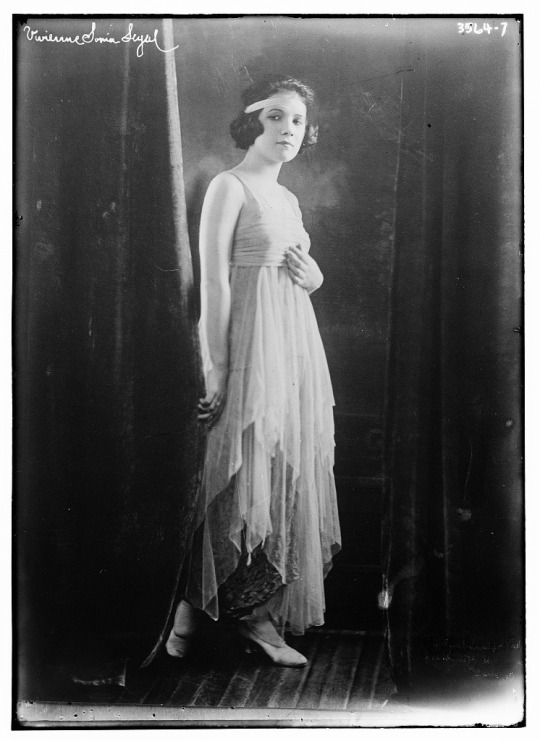
The musical is remembered not for its plot, but for containing one of Romberg’s runaway hit songs, “Auf Wiedersehn”. It was also notable for being the Broadway debut of Vivienne Segal, who took over the leading role of Mizzi during out-of-town tryouts in Washington DC. It launched an impressive career.

Speaking of out-of-town tryouts, The Blue Paradise played at Atlantic City’s Apollo Theatre on June 15, 1915. Cecil Lean (Rudolph) was the star of note. Reviews were mixed.
“Miss Mayfield...her songs were delivered in a region of the head known in surgery as the occipital frontalis, and most of her lines were chanted, rather than spoken.” ~ LOUIS W. CLINE, PRSS OF ATLANTIC CITY
The out-of-town tour also played Providence RI, Hartford CT, Washington DC, Asbury Park NJ, and Long Branch NJ.

Just days before the Broadway opening, producers postponed for a few days to make some last-minute adjustments to the cast. This was likely to give Vivienne Segal, who had recently replaced a performer said to be ill, more time to adjust to the principal part of Mizzi.
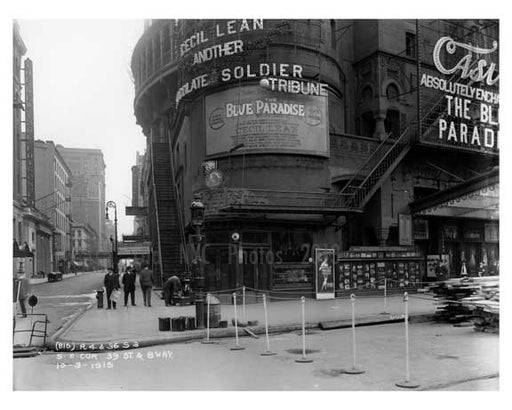
The Blue Paradise opened on Broadway on August 15, 1915 at the Casino Theatre on Broadway and 39th Street. It was a smash hit. At the end of May 1916, the show moved to the 44th Street Theatre to make way for another smash hit, Very Good Eddie. Eddie had been evicted from its first home, the popular Princess. Blue finished up at the 44th Street a month later with a record-setting run of 356 performances. It is now considered the fourth longest run of a book musical during the 1910s.

In February of 1930, the Casino Theatre was demolished to make room for the expanding garment district. The 44th Street Theatre was razed in 1945 to add to the New York Times building.
A pre-air conditioning story about The Blue Paradise:

“It was warm last night - very warm. It was the sort of a night that makes the theatre ono of the lost places the general public thinks of going. The real test of it theatrical production's merit Is the 87-in-the-shade evening. Half a house means It Is a hit; three-quarters a big success, and capacity a marvelous show good for a year on Broadway. The mediocre play cannot successfully combat heat, whereas It may struggle along fairly well against rain or cold. And all this brings me to my story, I stepped up to the box office at the Casino last night, possessing an ambition to see ‘The Blue Paradise.’ Good seats would be plentiful, I thought, because of the heat. Tickets for the last two seats on the lower floor were handed me and the treasurer said I was lucky to have arrived early enough to get them. The house was sold out.”

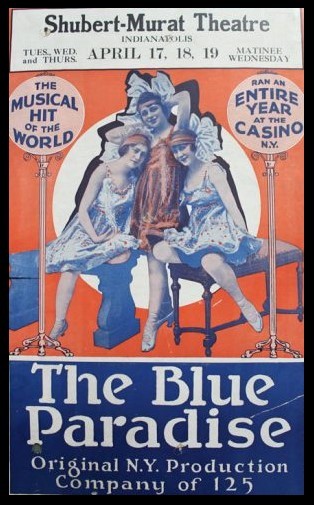
In the Fall of 1916, the show spawned three road companies that began in Chicago, Philadelphia, and Brooklyn, respectively.
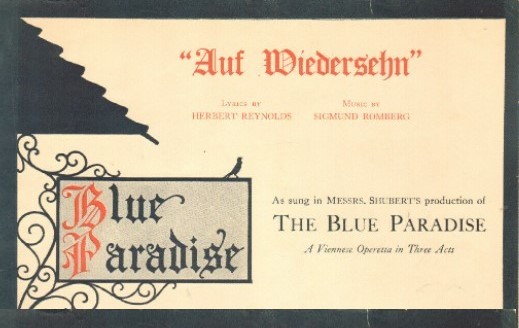
The song “Auf Wiedersehn” was heard in the 1932 musical short Mail Order Bride. In 1954, it was on screen again, sung by Helen Traubel, in the Sigmund Romberg biopic Deep in My Heart.
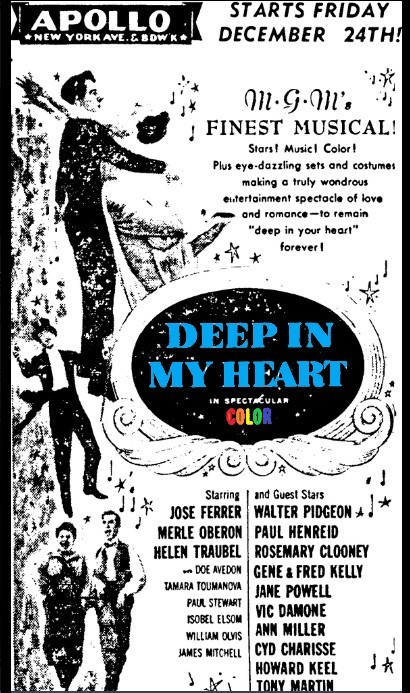
The film premiered in Atlantic City on Christmas Eve at the Apollo Theatre on the Boardwalk, the same venue that had hosted the live out-of-town tryout of The Blue Paradise nearly 40 years earlier. Although it was only for the span of “Auf Wiedersehn” - that brings this blog full circle.
#Blue Paradise#Operetta#Broadway#Broadway Musical#Auf Wiedersehn#Sigmond Romberg#Deep in My Heart#Vivienne Segal#Atlantic City#apollo theatre#Boardwalk#Casino Theatre#44th Street Theatre
35 notes
·
View notes
Photo

薔薇(ばら) 「ヘレン トローベル」 Rose ‘Helen Traubel’
246 notes
·
View notes
Text
#pipe dream#suzy is a good thing#music#showtunes#i got eyes that can see pretty sunsets and pretty dresses in store winders#and i got ears that can hear music and the sound of waves on a beach#i got a nose that can smell flowers and food cookin' on a stove#suzy is a good thing this i know is true#she may make a few mistakes as other people do everybody makes a few
0 notes
Text





Final installment of "Jerry Tortures Helen with His Love"
These two are the epitome of the "awww" face
#jerry lewis#helen traubel#the jerry lewis show#cutie patooties#awwww <3#luv luv luv luv luv luv luv to infinity
20 notes
·
View notes
Link
0 notes
Photo






The Ladies Man (1961).
28 notes
·
View notes
Photo

Remembering Jose Ferrer on his birthday, here with Helen Traubel in DEEP IN MY HEART ('54)
24 notes
·
View notes
Text
Deep in My Heart *** (1954, José Ferrer, Merle Oberon, Paul Henreid, Walter Pidgeon, Helen Traubel) - Classic Movie Review 9978
Deep in My Heart *** (1954, José Ferrer, Merle Oberon, Paul Henreid, Walter Pidgeon, Helen Traubel) – Classic Movie Review 9978
Director Stanley Donen’s 1954 Eastmancolor MGM musical Deep in My Heart is another one of Hollywood’s starry biopics of a composer – this time starring José Ferrer as the Hungarian-born US composer of operettas Sigmund Romberg (1887-1951).
Deep in My Heart is nothing to write home about as a meaty yarn, but the old-time songs are sweet and the lavish MGM production includes entertaining…
View On WordPress
0 notes
Text
Her voice a “gleaming sword”
Helen Traubel, 16 June 1899 - 28 July 1972

InternetMovieDatabase • AllMusic

Great Wagnerian Voice • Naxos

St Louis Walk of Fame
youtube
youtube
youtube
youtube
youtube
0 notes